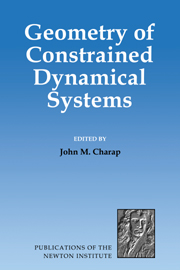Book contents
- Frontmatter
- Contents
- The network
- Preface
- The constraint algebra of higher dimensional Chern-Simons theories
- Nonrelativistic Chern-Simons vortices from the constrained Hamiltonian formalism
- Classical solutions of gravitating Chern-Simons electrodynamics
- Exponentially localised instantons in a hierarchy of Higgs models
- Obstructions to ganging WZ terms: a symplectic curiosity
- Global aspects of symmetries in sigma models with torsion
- Canonical structure of the non-linear σ-model in a polynomial formulation
- A manifestly gauge-invariant approach to quantum theories of gauge fields
- On the Hamiltonian formulation of higher dimensional Chern-Simons gravity
- An Example of Loop Quantization
- Gauge fixing in constrained systems
- Light-cone formulation of gauge theories
- Hamiltonian constraints and Dirac observables
- Gauging kinematical and internal symmetry groups for extended systems
- On the harmonic interaction of three relativistic point particles
- Non existence of static multi-black-hole solutions in 2+1 dimensions
- Spherically symmetric gravity and the notion of time in general relativity
- Canonical decomposition of Belinskii-Zakharov one-soliton solutions
- Hamiltonian reduction and the R-matrix of the Calogero model
- Intrinsic approach to the Legendre transformation in super-mechanics
- Field-antifield description of anomalous theories
- Transfer matrix quantization of general relativity, and the problem of time
- The W3-particle
- Pure geometrical approach to singular Lagrangians with higher derivatives
- Dirac versus reduced phase space quantization
- Classical and quantum aspects of degenerate metric fields
- BRST-antibracket cohomology in 2d conformal gravity
- Quantisation of 2 + 1 gravity for g = 1 and g = 2
- Geometry and dynamics with time-dependent constraints
- Collective coordinates and BRST transformations or Gauge theories without gauge fields
- Geometry of fermionic constraints in superstring theories
- BRST and new superstring states
- Generalized canonical quantization of gauge theories with polarized second–class constraints
- Radiation field on superspace
- Participants
Canonical decomposition of Belinskii-Zakharov one-soliton solutions
Published online by Cambridge University Press: 05 November 2011
- Frontmatter
- Contents
- The network
- Preface
- The constraint algebra of higher dimensional Chern-Simons theories
- Nonrelativistic Chern-Simons vortices from the constrained Hamiltonian formalism
- Classical solutions of gravitating Chern-Simons electrodynamics
- Exponentially localised instantons in a hierarchy of Higgs models
- Obstructions to ganging WZ terms: a symplectic curiosity
- Global aspects of symmetries in sigma models with torsion
- Canonical structure of the non-linear σ-model in a polynomial formulation
- A manifestly gauge-invariant approach to quantum theories of gauge fields
- On the Hamiltonian formulation of higher dimensional Chern-Simons gravity
- An Example of Loop Quantization
- Gauge fixing in constrained systems
- Light-cone formulation of gauge theories
- Hamiltonian constraints and Dirac observables
- Gauging kinematical and internal symmetry groups for extended systems
- On the harmonic interaction of three relativistic point particles
- Non existence of static multi-black-hole solutions in 2+1 dimensions
- Spherically symmetric gravity and the notion of time in general relativity
- Canonical decomposition of Belinskii-Zakharov one-soliton solutions
- Hamiltonian reduction and the R-matrix of the Calogero model
- Intrinsic approach to the Legendre transformation in super-mechanics
- Field-antifield description of anomalous theories
- Transfer matrix quantization of general relativity, and the problem of time
- The W3-particle
- Pure geometrical approach to singular Lagrangians with higher derivatives
- Dirac versus reduced phase space quantization
- Classical and quantum aspects of degenerate metric fields
- BRST-antibracket cohomology in 2d conformal gravity
- Quantisation of 2 + 1 gravity for g = 1 and g = 2
- Geometry and dynamics with time-dependent constraints
- Collective coordinates and BRST transformations or Gauge theories without gauge fields
- Geometry of fermionic constraints in superstring theories
- BRST and new superstring states
- Generalized canonical quantization of gauge theories with polarized second–class constraints
- Radiation field on superspace
- Participants
Summary
Abstract
We perform the standard canonical (3+1) decomposition of the Belinskiĭ-Zakharov one-soliton solution. Our starting point is the general Bianchi I solution which we obtain by applying the symmetry transformation to the Kasner metric. We then construct the symplectic form for the Bianchi I model and on the way show that we have all the physical degrees of freedom for our starting solution. The Belinskiĭ-Zakharov soliton transfomation requires two degrees of freedom in the general Bianchi I solution to be frozen. Although integration of the linearized system, in the non-diagonal case, is a non-trivial step, the particular form of our starting solution simpifies the calculation and reduces the problem effectively to the diagonal case. Therefore, in our case, it is straightforward to obtain the one-soliton metric. Finally, we point out the problems related to the fact that the one-soliton solution is defined only in a certain region of the co-ordinate chart.
Introduction
The Einstein field equations for space-times that admit a two-dimensional Abelian group of isometries which acts orthogonally and transitively on non-null orbits are non-linear partial differential equations in two variables [Kramer et al. 1980]. Since the pioneering work of Geroch, it has been known that the field equations in the stationary axisymmetric case admit an infinite dimensional group of symmetry transformations [Geroch 1971, 1972]. This result has encouraged the research in solution-generating methods, the main idea being that the complete class of solutions can then be generated from a particular solution, such as flat space [Cosgrove, 1980-1982].
Information
- Type
- Chapter
- Information
- Geometry of Constrained Dynamical Systems , pp. 173 - 185Publisher: Cambridge University PressPrint publication year: 1995
